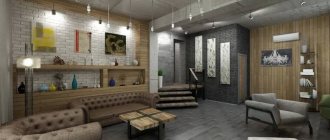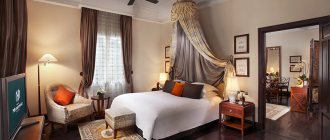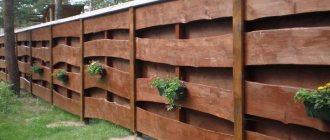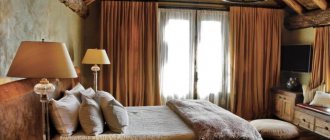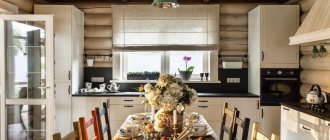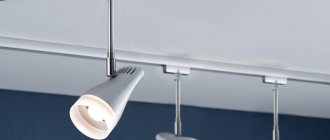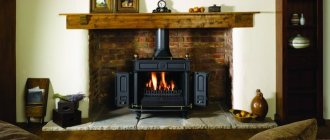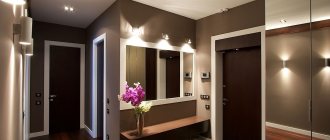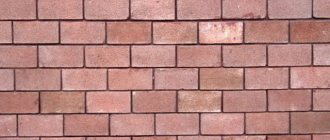It is quite difficult to create maximum comfort and coziness of living in cottages remote from the noisy streets of the metropolis, without creating the correct lighting for the building and the site itself. Decorative lighting for a country house can be done in different ways, using a variety of lamps.
Additionally, the backyard area can be illuminated: vegetation, paths, gazebos or small architectural forms. The work of lighting areas is painstaking and requires careful study of the nuances of selecting illuminators, laying wires, and drawing up a project. Below we have told you all about the features of such lighting and its capabilities.
With the correct combination of lighting fixtures that are different in functionality, type of control and characteristics, you can easily create an amazing exterior design for your home and emphasize the originality of your landscape design.
- About decorative lighting
- Types of street lighting
- Types and variety of lamps Type of lighting
- Home lighting
About decorative lighting
Street decorative lighting is a facade illumination device. It can be carried out both for all walls and to highlight individual elements of the structure. It is used to create comfortable conditions for moving around the house or safe walking in the area around the house itself. A separate branch of decorative street lighting is the illumination of certain elements of the garden: paths, plants, pergolas and gazebos, artificial ponds.
When organizing decorative lighting at home, the following principles are pursued:
- Taking into account the landscape design, the exterior of the building and the style of the lighting fixtures themselves.
- Accurate planning of object placement and wiring.
- Assessing the general appearance of the area and the sufficiency of lighting (excluding excess or lack of light).
- Taking into account the peculiarities of connecting light (or choosing autonomous illuminators).
- Complete safety of the selected objects and their compliance with existing requirements (especially for lamps located near bodies of water).
Types of street lighting
Before choosing the optimal plan for lighting your country house and the area around it, you need to take into account the different purposes of street lighting. It can be divided into two large groups:
- Utilitarian (functional).
Ensures safety of movement around the site and near buildings. Additionally, it is divided into several types: accompanying, marking, technological. Accompanying light includes lamps with motion sensors that light up when someone passes next to them. Technological light is used to illuminate utility buildings. But the markings indicate particularly “dangerous” areas and objects: entrances to the yard and garage, steps, various kinds of obstacles that are invisible at night.
- Decorative.
It is used to improve the appearance of the garden and yard, and the house itself. An important requirement for such lighting is aesthetics and attractiveness.
Both functional and decorative light should not disturb neighbors. Take this requirement into account when arranging your site.
How to install lamps in a suburban area
It is highly recommended to entrust all work on laying cables and connecting electrical appliances to professionals. But it will not be superfluous for ordinary users to understand the process at a superficial level.
The general principles of electrical installation in a country house are as follows:
- in the center of the diagram there is a distribution panel. Several groups of wires extend from it: a separate one to the house, to the street and to outbuildings. Wires are laid overhead or underground;
- underground wiring is the most practical. It does not spoil the appearance of the site, is not exposed to the external environment and mechanical damage, but requires a long preparatory stage. Laying work should begin before the landscape around the cottage is designed, but there should already be a clear plan of where and what will be placed on the site, so as not to have to redo it later;
- all wires laid underground must be protected by an insulating layer and an outer box, laid at least 0.7 m from the surface level;
- overhead wiring is installed on high supports with a height of at least 3 m or under some kind of cover - for example, a roof canopy. This minimizes possible damage;
- street light should be directed in such a way as not to hit the windows of a country house - neither yours nor your neighbors;
- it is better if the light spots of different lamps do not intersect with each other - such a small thing can spoil the overall design of the exterior;
- street switches must be protected from precipitation and direct rays of the sun - for this case there are special models with covers;
- grounding is a stage of wiring that should never be ignored;
- The easiest way to save on electricity in a country house is with the help of solar panels, motion sensors, and twilight sensors.
You can purchase lamps for interior or exterior lighting of a country house and all their accessories in a chain of stores or on the Brille website.
Types and variety of lamps
Street lighting fixtures are sold in modern stores in any format and with any characteristics. Elements used for decorative lighting include:
- spotlights: they produce a bright stream of light, are optimal for highlighting large areas or objects, and can be fixed in any place;
- wall-mounted street lights: used to illuminate building facades, gazebos, pergolas;
- decorative light bulbs: spotlights used to illuminate certain areas (located around the perimeter) or for spot lighting of the garden (bushes, flower beds);
- garlands and ribbons: bright lighting fixtures that create soft light throughout their entire length are ideal for decoration and discreet lighting of paths and buildings;
- lamps for ponds: a separate type of device that has high protection against moisture.
It is worth considering that there are both conventional and autonomous models (with solar panels). The rules for their installation and ease of use directly depend on the specific operation of the devices.
Lighting type
The overall appearance of the area being developed and the exterior of the house directly depends on the brightness and temperature of the selected lamps. That is why when selecting lamps you need to pay attention to the temperature of the light received.
Cold light will provide more discreet, harmonious illumination of the area and will help highlight individual elements of the garden or parts of the facade. Warm light (similar to morning sunlight) will emphasize the comfort of relaxing in the fresh air and provide a special atmosphere. As for the color of the glow itself, it also affects a person’s perception of the overall picture. The yellow shade is conducive to relaxation and promotes harmony.
White light can be called neutral: it will minimally affect the owners of the house and at the same time will not change the perception of the color scheme. Colored lamps (plain or changing color during operation) are more suitable for festive decoration of the area. Because with constant use they will not provide sufficiently high-quality illumination of important areas.
Lighting for living room and kitchen
Both the kitchen and living room are active rooms and are multifunctional. Lighting for the active areas of the house is developed to the maximum, and is provided for at the earliest stages of designing a house - when choosing the orientation of the main rooms according to the cardinal points.
The best options for natural lighting are the orientation of the room to the south and east; this part of the house is usually reserved for the children's room, living room and kitchen. Summer dining shading is done depending on the level of insolation. Evening electric lighting should in any case be uniform and warm.
In country houses, the kitchen is a very special room, and modern layouts position the kitchen as a combined dining room and even a living room - family gatherings and receiving guests are convenient and justified in an active kitchen area with free space and good lighting. Proper lighting of such a multifunctional kitchen-dining room requires the organization of several lighting scenarios.
For receiving guests or a festive family dinner, organizing lighting requires a special approach, depending on the size and style of the existing room.
Modern pendant chandeliers of large sizes are appropriate in living rooms, and for intimate gatherings in the evening, the best option would be soft diffused and directional lighting with floor lamps and wall sconces; fabric lampshades and environmentally friendly lamps made of wood and textiles are in perfect harmony with quiet evenings.
The fireplace area of the living room also requires lighting, usually symmetrical - each side of the fireplace shelf is illuminated by a separate wall sconce, corner fireplaces are emphasized by floor lamps that provide dim directional light.
Light in recreation areas
For relaxation in any apartment or house there are separate, special zones, and the lighting of these zones should be soft, promoting relaxation - this could be a floor lamp, a floor lamp or a suspended ceiling light with a “floating ceiling” design. Soft and cozy curtain lighting can be combined with floor lamps, sconces and ceiling lamps to create constant light.
For the bedroom, bedside areas are illuminated with symmetrically located sconces or table lamps with diffuser shades; usually these additional light sources are used for reading. For general lighting, pendant chandeliers, built-in ones, or LED lighting in tiered structures are used - the main choice is the personal preferences of the owners. One of the reasons for organizing general lighting is to reduce sudden changes in light brightness.
Lighting of stairs, hallways, lobbies, corridors
For the hallway, bright lighting is very important, since this room is the first to tell both the house and the owners, and should create the most favorable impression. Provided it is bright, the light should not cause visual discomfort when entering the hallway, but nevertheless be strong enough for comfort when gathering at the mirror before leaving the house.
Wall sconces are very appropriate in hallways, as in any part of the house - these lamps are very functional. Traditionally, sconces illuminate areas of rooms with mirrors and interior elements that people want to draw attention to.
A long corridor is perfectly illuminated by a number of single-plane lighting fixtures placed at the same height or in a given sequence. A visual narrowing of space occurs only when wall lamps are installed in one high-rise level symmetrically to the axis of a long corridor; one row, on the contrary, creates a slight effect of additional space.
Stairs must be illuminated; lighting of stairs is a requirement for safe operation. For stairs, diffused light lighting fixtures and lamps that provide low brightness are used; for LEDs this is only 3 W.
Special lighting for staircases with markers is modern and economical, and in terms of design it is a logical solution for creating an effect that can transform the entire lobby area. Markers today are considered to be the most advanced equipment for home lighting, and they provide enormous design possibilities - realistic imitations of natural scenes or simple flashlights, any choice will be successful.
Lighting network development
To create a competent diagram of the lighting network, it is imperative to draw up a detailed drawing of the site being developed (or simply make a photocopy of the existing design of the site). Further work on drawing up the plan is carried out as follows:
- The locations of switches for individual lighting systems and the electrical panel are marked. They must be located in the house (at least in the garage, where there is direct access from the house).
- The locations of different types of lamps are marked, indicating their brief characteristics (type, power).
- Lamps of one system (separately for the path, separately for the gazebo) are connected by a line, which determines the placement of the cable during installation. For each individual route, the required cable length and its parameters must be indicated.
When drawing up a diagram and marking it on the drawing, use markers of different colors (for different routes). This will greatly simplify subsequent installation.
Home interior lighting
First of all, the lighting inside the house itself must be safe for residents. It is also worth contacting specialists and drawing up the correct and competent lighting scheme for higher efficiency.
- Basic principles when placing light sources inside the house.
- Location of lamps and other devices in rooms.
- Places for control devices. Switches can be mechanical or more complex designs.
- Places for placing electrical appliance networks.
There are a number of standard lighting schemes for certain types of houses, but highly qualified specialists can develop an individual scheme specifically for your building.
Many people like to highlight different details in their home. Such details are stairs, various shelves and tables.
A great way to highlight a detail is to highlight it. For example, you can install many spotlights on the inside of your flight of stairs, and you can also install the same spotlights in cabinets with glass doors.
When creating a lighting scheme, you can show your imagination and create a unique design and atmosphere.
Lighting in the house is divided into diffused, directional and combined.
The directional light is sharp, clearly expressing various details and shadows on the subject. Diffused lighting evenly illuminates the subject, making it difficult to see shadows on it.
Combined light is an even combination of the two types of lighting listed above.
Cable installation and selection
If it is possible to lay a cable for street lighting by air (if the object is not far from the electrical panel), you need to use wires of the SIP-2, SIP-4, AVT, VVG-HL brands. Installation is carried out together with a cable: this protective measure will prevent stretching and breaking of the cable.
When laying underground, installation of wires without armor (auxiliary protection) must be carried out in plastic boxes, pipes or corrugations. The most popular cable for such work is VVG. VBBShv cable with special armor is used less frequently. The cable must be laid in a trench to a depth of at least 40 cm together with the box, or to a depth of at least 80 cm without the use of the box (with sufficient protection of the cable itself).
The selection of the required type of wire is carried out after calculating the total power of the lamps that will be connected to one route. For example, for 6 diode illuminators with a power of 36 W each, the total power will be 216 W. That is, a 1-core VVG cable with a minimum cross-section is suitable for work.
Home and plot lighting options
Creating decorative lighting for a country or residential house and garden can be done in different ways. Lighting can be used exclusively to illuminate individual “important” objects (for example, a garage, pantry, summer kitchen) or can be an addition to landscape design. In addition, it can be used to stylishly highlight plants on a site or create a safe zone around an artificial pond. But to install the right street light, you must take into account the following features:
- Land area
A small local area should not be overly “decorated” with lamps, otherwise the excess light will greatly spoil the landscape design. In larger areas, more lamps can be used.
- View from the window of the house
It is very important that the lighting created outside looks good from the cottage, highlighting objects beautifully and allowing them to be clearly viewed.
- Specifics of lamp operation
How exactly the power will be supplied, and in what mode they will operate: constantly or switched on by a motion sensor.
Home lighting
One of the most popular options for outdoor lighting of private homes is architectural. It involves illuminating the facade of the building. Depending on the location and specific lighting of the object, the following types of architectural lighting are distinguished:
- General (fill light)
Provides complete external illumination of the house due to the placement around it (or along the perimeter of the facade or base) of many low-power floodlights.
Allows you to highlight the most “interesting” elements of the structure (for example, the roof of a column, decorative elements of the facade).
To create such lighting for country cottages, special lamps are installed that are practically invisible. They are usually equipped with a deep body and bright lamps. They are mounted on the facade to improve the appearance of the building and highlight individual parts in silhouette.
Lighting for gazebos and verandas
In verandas attached to the house itself, several ceiling lights are often installed. They can also be replaced by wall models that look like street sconces (lanterns, hemispheres). Wires are laid directly from the house. In the case of lighting gazebos remote from the main building, you can use the following options:
- decorative garlands: outdoor garlands can be hung from the ceiling along the perimeter of the canopy, wrapped around separately located pillars of metal and wooden gazebos;
- LED strips: unlike garlands, they are not suspended, but are attached directly to the ceiling or gazebo posts;
- hanging lanterns: they are fixed under the ceiling of the gazebo, but require careful installation of the cable and its secure fixation (if necessary, additional supports will be required to support the wires).
Track lighting
Owners can easily create beautiful, high-quality lighting for garden paths with their own hands. To illuminate the area and create safe conditions for moving around it at night, it is recommended to use wireless lights. For example, along the path you can install neat LED lamps on supports (about 30-50 cm), equipped with a solar battery.
An autonomous illuminator will accumulate energy during the day and constantly glow at night. There are similar devices that are almost completely recessed into the ground. Another option for lighting paths is LED strips mounted on the inside of the curb framing the path. For tiled or stone paths, it is also possible to install recessed floor lamps. They are equipped with wear-resistant durable glass.
Illumination of flower beds, shrubs and trees
Creating an unusual landscape design in a spacious yard involves installing lamps not only around paths, but also near shrubs, trees and flower beds. It is recommended to illuminate trees and shrubs using powerful spotlights.
They should be installed under the plant, with the light directed towards the object. Such illumination of the adjacent area creates special comfort of movement and harmony in the overall appearance of the territory. To organize lighting, careful design will be required, taking into account the landscape and the distance of objects from each other.
The laying of wires must be hidden (underground installation or sprinkling the protective corrugation with crushed stone, mulch). Outdoor LED garlands can also be used as tree lights. Illumination of large flower beds is carried out with spotlights or LED strips. The latter are located along the perimeter of the border, due to which soft light falls from it to the plants of the flowerbed.
Lighting for ponds and pools
Around swimming pools and artificial reservoirs, lighting is organized using lamps that are resistant to moisture. They have a sealed housing that prevents moisture from entering the batteries or device circuits.
Installation of products is carried out around the perimeter of the pool or in the area framing it from decking boards and other materials. Direct lighting of the interior should be carried out by special devices installed in the walls and floor of the reservoir. Additional lighting for pools and ponds can be created with floating lights. Such models can additionally create fog over the surface of the reservoir.
Installation of internal lamps in a pool or pond should be carried out at the time of construction (or complete drainage of the reservoir) using sealed wires protected from water.
Features of decorative lighting of a country house
The idea of a country house for a city dweller is to create a relaxing place where you can forget about the daily hustle and bustle, work problems, and noisy neighbors. Each owner makes a lot of efforts to make the house as comfortable, cozy and beautiful as possible. Decorative lighting for a country house copes with this task perfectly.
Modern lighting technologies have undeniable advantages:
- Adjustable lighting brightness;
- Application of solar panels;
- Adjusting the operating time of light bulbs;
- Turning on decorative lighting of a country house using motion sensors or a timer;
- Creation of enchanting special effects on the personal territory.
You can independently develop a project for a lighting system for a country house, however, if you have never done this, then it is better to turn to professionals. Decorative lighting for a country house must not only provide the necessary luminous flux, but also be absolutely safe. In any city there are many companies specializing in creating outdoor lighting projects that can easily and quickly bring to life any lighting ideas of clients.
Street lighting can be:
- decorative;
- utilitarian.
Utilitarian lighting of a personal plot allows for safe movement around the territory in the dark. Good illumination of the porch of the house, the entrance to the garage, as well as garden paths will allow you to comfortably be on the site even at night. A simple and inexpensive option is to distribute the lights evenly along the paths.
Decorative lighting of a country house can give the site uniqueness and emphasize the sophistication of the taste of its owners. Proper distribution of lighting in all flower beds, fountains and garden sculptures creates a magical atmosphere. Depending on the owner’s wishes, the site can become romantic, mysterious, dramatic or festive. His nighttime look will be significantly different from his daytime look.
Festive decorative lighting of the site
Many owners of country cottages often carry out non-standard decorative lighting on the eve of holidays (New Year, Easter, March 8). To create a special atmosphere, you can use the following types of lamps:
They can be completely wrapped around trees or used to stylize the facade: placed above window openings, along the perimeter of the roof. For trees, garlands in the form of thin sticks with LEDs inside can also be used.
- Grids with LEDs (a subtype of modern garlands)
They can be fixed in flower beds or placed on the walls of the house.
- Glowing figures
They are a metal frame supplemented with LEDs. They produce a bright, soft light, allowing you to illuminate a small area around you. There are also small figures (in the form of New Year's wreaths, flowers or flat silhouettes) that can be mounted on the facade for festive lighting.
Safety first!
Following the rules and complying with regulations will help guarantee the correct and, most importantly, safe operation of street lighting at home. Therefore, before starting work, you need to study the following requirements:
- System reliability
For lighting installations, it is necessary to use cables and illuminators designed for outdoor use. Additionally, when choosing, you should take into account the weather conditions of your region: maximum temperature in summer and winter, frequency of precipitation.
- Permissible load
The connection of lamps to the machine should be carried out taking into account their quantity and energy consumption. If necessary, different types of lighting (paths, gazebos, facades) must be connected to separate machines.
- High-quality cable routing
If possible, installation of wires should be carried out by air. But to connect the cable to remote elements, it is recommended to lay it underground.
You can install autonomous lamps with a solar battery with your own hands. Direct wiring and installation of lamps should be trusted only to professionals with extensive experience in the field of street lighting.
